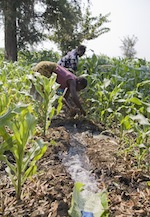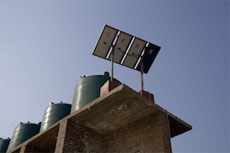Thursday, April 18, 2024
News and Views from the Global South
SOUTH AFRICA: While Politicians Deliberate Climate Change, Others Adapt
- While many scientists, academics and politicians still theorise about ways to adapt to climate change, a South African civil society organisation has launched a hands-on project that mobilises communities to take easy steps to reduce carbon emissions.
Called the Project 90 by 2030, it encourages individuals, organisations and companies to change the way they live and operate by 90 percent by the year 2030. The idea stems from the suggestion environmental activist George Monbiot makes in his book “Heat” that industrialised nations need to reduce their carbon footprint by 90 percent by 2030.
“It’s a goal-oriented, praxis-oriented approach. It’s actually very simple,” says Project 90 by 2030 director Brenda Martin.
The project’s main purpose is to challenge South Africans to change the way they live and how they relate to the environment, she explains. “As the biggest carbon emitter on the continent, South Africa has the biggest responsibility in Africa to fight climate change,” Martin notes.
With the firm belief that every person can make a small contribution to a healthier environment, Martin suggests that individuals start by reducing their carbon footprint by just 10 percent a year and “keep at it, until they reach 90 percent over several years.” It’s about setting achievable goals, she explains.
Still, Martin is keenly aware of the urgency of preventing further climate change. “If we move as slowly as we do now, we will run out of time to reduce carbon emissions,” she says. “But I do believe that we can make a change. There are sufficient clean energy supply options available to us.”
To set an example, the Project 90 by 2030 initiative has built 15 renewable energy demonstration sites throughout the country over the past four years. The sites showcase affordable, practical solutions, such as biogas digesters, solar panels and solar water heaters. This way, the organisation wants to demystify renewable energy generation for the public and show how renewable energy can provide sufficient, reliable and cheap energy that will not impact negatively on professional activities.
“We want to show people what they can do to reduce climate change on a day-to-day basis,” explains Martin. “Everyone can and must do something. While decision makers continue to deliberate, we are getting on with it.”
One of the demonstration sites is the Johannesburg Zoo, which installed 15 large solar panels on the roof of its education centre to reduce its carbon footprint.
“At the moment, the solar power is fed into the electricity grid, but in future, we hope to make the centre entirely carbon neutral,” says the head of the Zoo’s green team, Lorna Fuller.
The zoo is also running its restaurant with the help of a biogas digester. “We feed kitchen scraps and animal waste into the digester to convert it into gas that we use for cooking in the restaurant,” explains Fuller.
Participating in the initiative was a no-brainer for the zoo management, Fuller says, since “we worry about the impact climate change will have on the environment and the habitat of animals.”
Since the zoo has half a million visitors a year, Fuller hopes that its environmental showcase will find many imitators. “We show visitors how it all works. Some people visit the zoo especially to look at our green installations,” she says.
Project 90 by 2030 is also running 30 school clubs where children get involved in simple, hands-on climate change projects, such as energy saving drives or recycling projects. The only condition: the projects need to have a wider impact than just on the school. They need to benefit the entire community around it. “That’s how we ensure we achieve a broad effect on large groups of people,” Martin explains.
Once projects are up and running for several weeks, the pupils learn how to assess them and measure how much energy, water and carbon emissions have been saved.
“We decided to work with school children to help create a next generation that is more aware of climate change and what can be done,” says Martin. “We want to shape young people and encourage them to create a better world.”
At the Springfield Convent Senior School in Cape Town, a group of pupils started their Project 90 by 2030 involvement with a ‘green audit’ to assess their school’s electricity and water usage as well as how much waste they produce.
The outcome was worrisome, and the learners decided to make some important changes to how their school is managed: they installed low-flow showerheads, geyser blankets as well as a water metre for the river that flows through the school ground, which they use to irrigate the gardens. They also started to recycle waste and use less paper.
“We put an emphasis on individual actions that become a lifestyle and have a collective effect,” says the schools head of geography Fiona Smith, who facilitates the school club. Many of the pupils have also begun to implement similar initiatives in their homes.
Says Smith: “We hope our pupils will grow into adults that treat our planet with more care.”

 Print
Print





